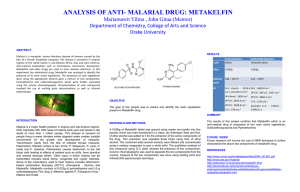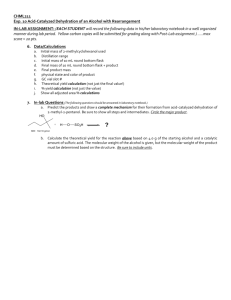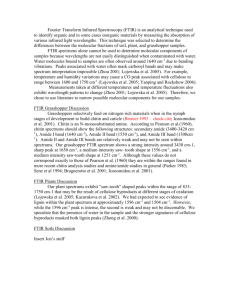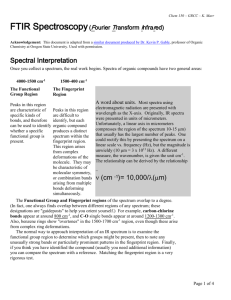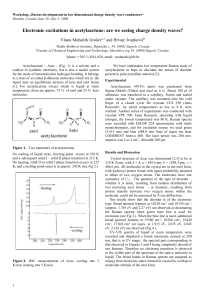DOCX
advertisement
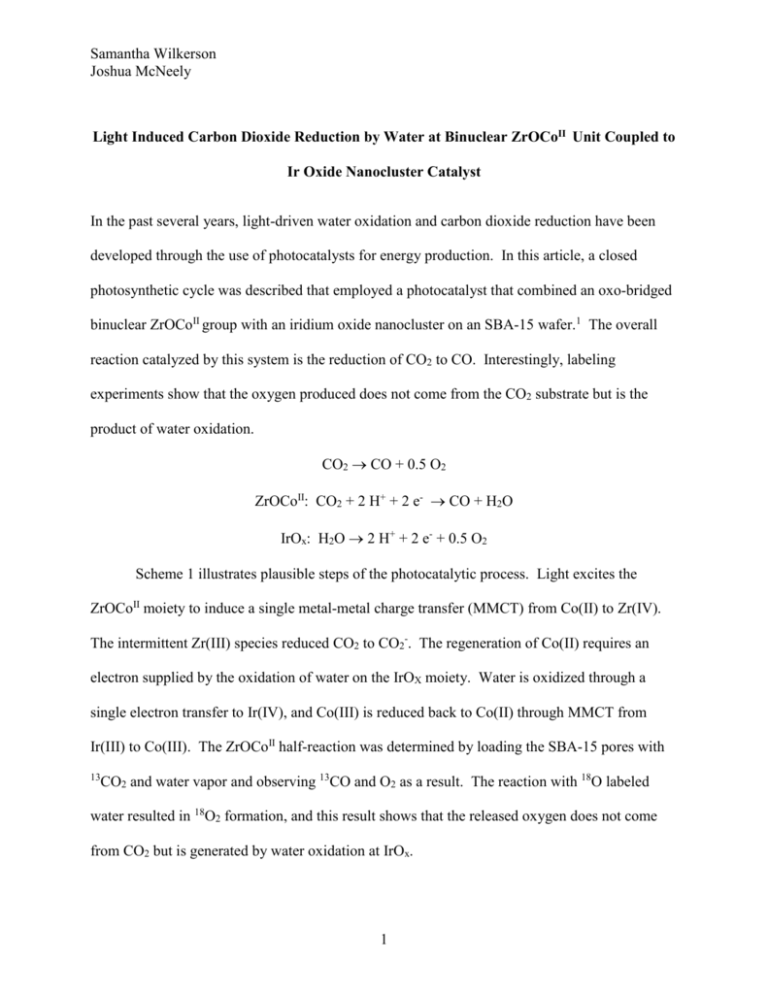
Samantha Wilkerson Joshua McNeely Light Induced Carbon Dioxide Reduction by Water at Binuclear ZrOCoII Unit Coupled to Ir Oxide Nanocluster Catalyst In the past several years, light-driven water oxidation and carbon dioxide reduction have been developed through the use of photocatalysts for energy production. In this article, a closed photosynthetic cycle was described that employed a photocatalyst that combined an oxo-bridged binuclear ZrOCoII group with an iridium oxide nanocluster on an SBA-15 wafer.1 The overall reaction catalyzed by this system is the reduction of CO2 to CO. Interestingly, labeling experiments show that the oxygen produced does not come from the CO2 substrate but is the product of water oxidation. CO2 CO + 0.5 O2 ZrOCoII: CO2 + 2 H+ + 2 e- CO + H2O IrOx: H2O 2 H+ + 2 e- + 0.5 O2 Scheme 1 illustrates plausible steps of the photocatalytic process. Light excites the ZrOCoII moiety to induce a single metal-metal charge transfer (MMCT) from Co(II) to Zr(IV). The intermittent Zr(III) species reduced CO2 to CO2-. The regeneration of Co(II) requires an electron supplied by the oxidation of water on the IrOX moiety. Water is oxidized through a single electron transfer to Ir(IV), and Co(III) is reduced back to Co(II) through MMCT from Ir(III) to Co(III). The ZrOCoII half-reaction was determined by loading the SBA-15 pores with 13 CO2 and water vapor and observing 13CO and O2 as a result. The reaction with 18O labeled water resulted in 18O2 formation, and this result shows that the released oxygen does not come from CO2 but is generated by water oxidation at IrOx. 1 Samantha Wilkerson Joshua McNeely The deposition of Ir(acac)3 proceeds with partial oxidation and forms an IrOx with iridium ion oxidation states III and IV. The FT-IR spectra recorded during photodeposition (Figure 1) shows the disappearance of [IrIII(acac)3] bands and an increase in [IrIV(acac)2]2+ bands as the result of partial oxidation of Ir(III) to Ir(IV). Figure 2 shows the progress of photodeposition over 60 minutes until the complete conversion of all Ir(acac)3. (1) Kim, W.; Yuan, G.; McClure, B. A.; and Frei, H. Light Induced Carbon Dioxide Reduction by Water at Binuclear ZrOCoII Unit Coupled to Ir Oxide Nanocluster Catalyst. J. Am. Chem. Soc. 2014, 136, 11034-11042. 2 Samantha Wilkerson Joshua McNeely Scheme 1. Plausible Reaction Chemistry of the ZrOCo-IrOx Photocatalyst 3 Samantha Wilkerson Joshua McNeely 0.35 Absorbance 0.25 0.15 Function 1 Function 2 Function 3 Sum of Functions 0.05 -0.05 1900 1800 1700 1600 1500 1400 1300 Wavenumber (cm-1) Figure 2. Simulation of the FT-IR spectrum recorded after calcination, trace 3. 𝑖=3 ̅ −𝜈 ̅𝑚𝑎𝑥 )2 −(𝜈 ℎ 1 2𝜎2 𝑓(𝜈̅ , 𝟑) = ∑ 𝑓𝑖 (𝜈̅ ), 𝑤ℎ𝑒𝑟𝑒 𝑓(𝜈̅ ) = 𝑒 𝑛 √2𝜋𝜎 2 𝑖=1 Function i: Position Width Height Normation Function 1: 𝜈̅ max,1 = 1860 cm-1 1 = 25 cm-1 h1 = 0.025 n1 = 0.0160 Function 2: 𝜈̅ max,2 = 1630 cm-1 2 = 35 cm-1 h2 = 0.06 n2 = 0.0114 4 Function 3: 𝜈̅ max,3 = 1250 cm-1 3 = 90 cm-1 h3 = 0.30 n3 = 0.0380 Samantha Wilkerson Joshua McNeely 0.03 0.02 0.01 Absorbance 0 Orange (trace 4) Red (trace 5) -0.01 Green (trace 6) -0.02 -0.03 -0.04 -0.05 1700 1600 1500 1400 1300 Wavenumber (cm-1) Figure 2. Simulation of the difference FT-IR spectra recorded in various stages of the photodeposition, traces 4, 5, and 6. 𝑖=𝑚 ̅ −𝜈 ̅𝑚𝑎𝑥 )2 −(𝜈 ℎ 1 2 2𝜎 𝑓(𝜈̅ , 𝑵) = ∑ 𝑓𝑖 (𝜈̅ ), 𝑤ℎ𝑒𝑟𝑒 𝑓(𝜈̅ ) = 𝑒 𝑛 √2𝜋𝜎 2 𝑖=1 For N = 4 (𝜈̅ max,m [cm-1], m [cm-1], hm, nm): 1680, 15, 0.0008, 0.0266 (m = 1); 1630, 20, -0.005, 0.0199 (m = 2); 1580, 10, 0.004, 0.0399 (m = 3); 1550, 6, -0.012, 0.0665 (m = 4); 1530, 6, -0.01, 0.0665 (m = 5); 1510, 8, 0.005, 0.0499 (m = 6); 1490, 3, 0.0009, 0.133 (m = 7); 1430, 10, -0.0007, 0.0399 (m = 8); 1385, 9, -0.004, 0.0443 (m = 9); 1362, 8, 0.003, 0.0483 (m = 10). For N = 5 (𝜈̅ max,m [cm-1], m [cm-1], hm, nm): 1680, 18, 0.0017, 0.0222 (m = 1); 1625, 15, -0.009, 0.0266 (m = 2); 1580, 25, 0.012, 0.0160 (m = 3); 1552, 8, -0.029, 0.0483 (m = 4); 1527, 5.5, -0.024, 0.0679 (m = 5); 1510, 8, 0.009, 0.0499 (m = 6); 1490, 2, 0.002, 0.199 (m = 7); 1470, 8, 0.0015, 0.0499 (m = 8); 1415, 8, 0.0022, 0.0499 (m=9); 1385, 6, -0.013, 0.0665 (m=10); 1360, 7, 0.012, 0.0570 (m = 5 Samantha Wilkerson Joshua McNeely 11). For N = 6 (𝜈̅ max,m [cm-1], m [cm-1], hm, nm): 1690, 20, 0.0013, 0.199 (m = 1); 1627, 12, -0.009, 0.0328 (m = 2); 1585, 17, 0.019, 0.0235 (m = 3); 1552, 6, -0.045, 0.0629 (m = 4); 1527, 5, -0.047, 0.0737 (m = 5); 1510, 6, 0.007, 0.0665 (m = 6); 1490, 2, 0.0015, 0.199 (m = 7); 1465, 5, 0.0017, 0.0798 (m = 8); 1415, 6, 0.0022, 0.0665 (m = 9); 1385, 8, -0.028, 0.0499 (m = 10); 1360, 7, 0.022, 0.0570 (m = 11). 6

